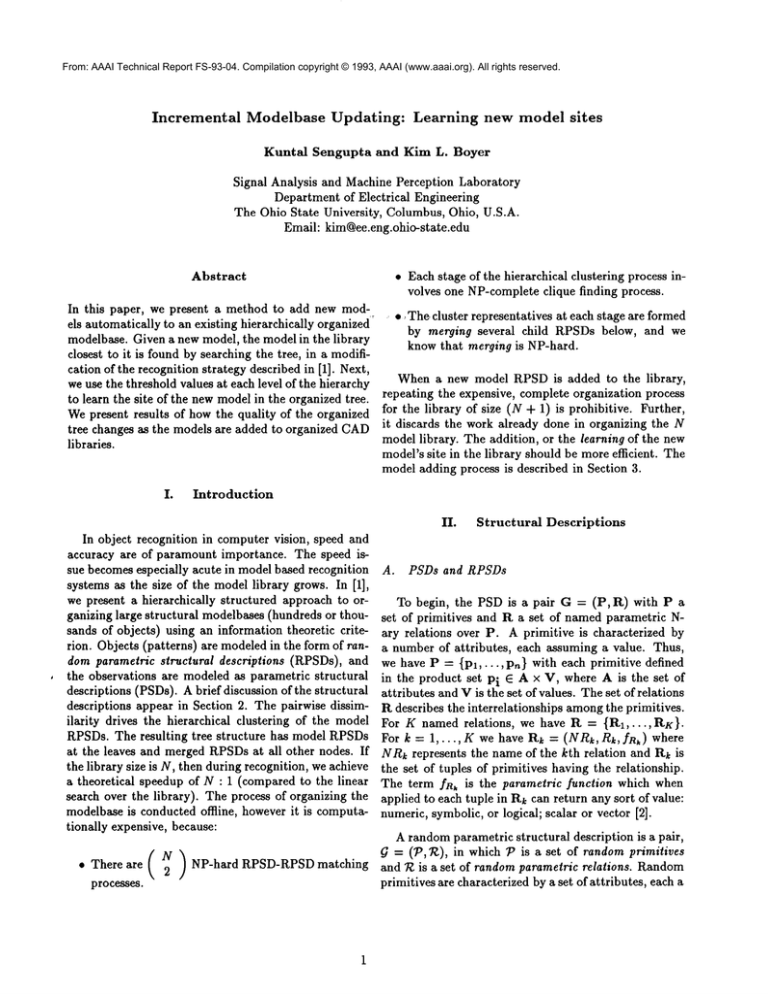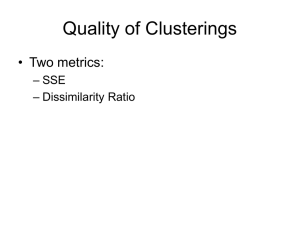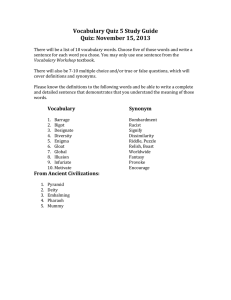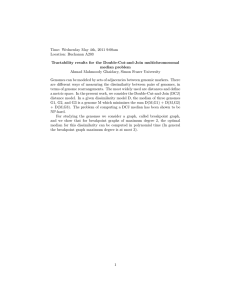
From: AAAI Technical Report FS-93-04. Compilation copyright © 1993, AAAI (www.aaai.org). All rights reserved.
Incremental
Modelbase
Kuntal
Updating:
Sengupta
Learning
new model
sites
and Kim L. Boyer
Signal Analysis and Machine Perception Laboratory
Department of Electrical Engineering
The Ohio State University, Columbus, Ohio, U.S.A.
Email: kim@ee.eng.ohio-state.edu
Abstract
* Each stage of the hierarchical clustering process involves one NP-completeclique finding process.
In this paper, we present a method to add new mod* ,The cluster representatives at each stage are formed
els automatically to an existing hierarchically organized .... by merging several child RPSDsbelow, and we
modelbase. Given a new model, the model in the library
know that merging is NP-hard.
closest to it is found by searching the tree, in a modification of the recognition strategy described in [1]. Next,
When a new model RPSDis added to the library,
we use the threshold values at each level of the hierarchy
repeating the expensive, complete organization process
to learn the site of the new modelin the organized tree.
for
the library of size (N + 1) is prohibitive. Further,
Wepresent results of how the quality of the organized
it
discards
the work already done in organizing the N
tree changes as the models are added to organized CAD
model
library.
The addition, or the learning of the new
libraries.
model’s site in the library should be more efficient. The
model adding process is described in Section 3.
I.
Introduction
II.
In object recognition in computer vision, speed and
accuracy are of paramount importance. The speed issue becomesespecially acute in model based recognition
systems as the size of the model library grows. In [1],
we present a hierarchically structured approach to organizing large structural modelbases (hundreds or thousands of objects) using an information theoretic criterion. Objects (patterns) are modeledin the form of random parametric structural descriptions (RPSDs), and
the observations are modeled as parametric structural
descriptions (PSDs). A brief discussion of the structural
descriptions appear in Section 2. The pairwise dissimilarity drives the hierarchical clustering of the model
RPSDs. The resulting tree structure has model RPSDs
at the leaves and merged RPSDsat all other nodes. If
the library size is N, then during recognition, we achieve
a theoretical speedup of N : 1 (compared to the linear
search over the library). The process of organizing the
modelbase is conducted offiine, however it is computationally expensive, because:
* There are
processes.
N)
2 NP-hard
RPSD-RPSD matching
A.
Structural
Descriptions
PSDs and RPSDs
To begin, the PSD is a pair G = (P, It) with P
set of primitives and tt a set of named parametric Nary relations over P. A primitive is characterized by
a number of attributes,
each assuming a value. Thus,
we have P = {Pl,.--,Pn} with each primitive defined
in the product set Pi E A × V, where A is the set of
attributes and V is the set of values. The set of relations
It describes the interrelationships amongthe primitives.
For K named relations,
we have R = {it1,--.,RK}.
For k = 1,..., K we have Itk = (NRk, Rk, fl~k) where
NRk represents the name of the kth relation and l~k is
the set of tuples of primitives having the relationship.
The term fRk is the parametric function which when
applied to each tuple in Itk can return any sort of value:
numeric, symbolic, or logical; scalar or vector [2].
A randomparametric structural description is a pair,
= (P, 7~), in which ~P is a set of randomprimitives
and 7~ is a set of randomparametric relations. Random
primitives are characterized by a set of attributes, each a
random variable. Each primitive also has an associated
probability of being null. A random parametric relation
is a named N-ary parametric relation with the parameter value for each tuple a random variable. Each tuple
also has a probability of nullity. The RPSDcaptures
the randomness in an object’s appearance. In recognition, we compute the probability of an observed PSD
as an outcome structure of the stored RPSDs,selecting
the most probable.
B.
n2- k by merging the unmatched primitives of ~2 with
nil. Nil is a dummyprimitive with probability of nullity
equal to 1. Relationship tuples in the merged RPSDare
computed similarly. Wedescribe operation merge below. For every primitive of the parent RPSD,we define
a node pointer list to identify the corresponding primitives in each child RPSD. Null children need not be
explicitly represented. For merged primitive P/M in G,
this list is:
Comparing two RPSDs
To organize the modelbase, we need to measure the
dissimilarity between any two models in the library.
This will drive the organization process. Following
Wongand You [3], we consider the increment of entropy. Given two RPSDsG1 and G2 corresponding to
models M1and M2, respectively, we merge them to produce a new RPSDand measure the increase in entropy
over the component descriptions:
6H (~1,~2)
H (~)
Pr[M,]H(~I)+Pr[M2]H(~2)
Pr[M]
nr + np
Z:g (P~) =
((~1,
M,)(~2,
G1, A~i-tO))
M2))
k+l<i<nl
((G,, m~’-n’)))
otherwise
(3)
The Node Pointer Lists are extended in the obvious
way when merging more than 2 RPSDs.
Once the dissimilarity
values for all model pairs
are obtained, they are hierarchically
clustered. At
each level, we group RPSDswhose dissimilarity values
are within some threshold dissimilarity values. These
thresholds correspond to the local minima of the histogram of the dissimilarity values [1].
(1)
where M is the merged model with RPSDG and the
III.
Adding New Models
minimumis taken over all interprimitive mapping functions (which define the merge). PriM1] and PriM2] are
the a priori probabilities of M1and M2, respectively
and and Pr[M] = PriM1] + Pr[M2]. Also note that A. Searching for the nearest model
b/~ (G1, G2) > 0. This measure is also invariant with respect to "size" because it is normalized by the number
To place the new model RPSDin the organization
of primitives (nr) and the number of tuples (nr) in
tree, we need to find the model RPSD(already existing
Webegin with two RPSDs, G1 = (Pl, 7~1) of model in the library) nearest to it. This is analogous to the
recognition process, wherein we find the model RPSD
M1 and G2 = (P2,7~2) of model M2, with number
primitives nl and n2, respectively. Suppose that the closest to the scene PSD. Weshould invoke the same
tree search process, however using the RPSD-RPSD
disstructural matcher produces matchlist ML:
similarity measure to traverse the tree.
P~M~]
I’~I
ML= { ( P~,, P~2)( P~,, P~I2)" "
. ~[PkM,,
The tree search consists of a recursive refinement of
The unmatched primitive sets of ~1 and G2 are A1 and the model identity by descending the modelbase hierarchy. At each level we keep severM options open. Assume
As respectively, where
that at level (r + 1) we have chosen a few best clusters
Ai = {A~,A~,...,A~m-k)},
i= 1,2
(2) for the new model I~PSD. Wecalculate the dissimilarity between the new model l~PSD and the representative
RPSDsof each child cluster (of each of these) at the next
The merged model M has RPSDG with (nl + n2)-k lower level r. The best cluster and all those which are
primitives. Of these primitives, k are formed by merg- "nearly as good" are retained for further search. The
ing each of k pairs of matched primitives, nl - k by best cluster is that whose representative RPSDhas the
with respect to the new model
merging unmatched primitives of G1 with a nil, and minimumdissimilarity
RPSD. Those which are "nearly as good" have dissimilarity values within 20%of the minimum.At the leaves,
we select the closest fitting model.
at every level in the organization hierarchy. At a particular level, the intercluster dissimilarity measure(de)
is the the average dissimilarity between two models belonging to two different clusters at that level. Similarly,
the intracluster dissimilarity measure (da) evaluates the
average dissimilarity between two models belonging to
the same cluster at that particular level.
In the worst case, RPSD-RPSD
comparisons involve
computation exponential in the number of primitives in
the RPSDs. However, once we obtain the interprimitive mapping function between the new RPSDand the
The figure of merit (I) at a level is given by:
root RPSD, this mapping along with the node pointer
lists predetermine the mapping between the new RPSD
da
and all subsequent cluster representatives, all the way
I = -(4)
d~
to the leaves. Therefore, once the models are organized,
the structural matching process is carried out just once
At the root, this ratio is infinity and at the lowest
per recognition attempt. The rest of the search process becomes just a sequence of distance measurements level in the hierarchy, it is 0. However,as we will see
under the inferred mapping, each linear in the number later, I usually does not increase monotonically as we
of RPSDprimitives, rather than exponential. We now climb the hierarchy.
have one exponential problem, followed by a logarithmic
(in the number of models) number of linear problems.
This is a significant advantage.
Experimental Results
IV.
B.
Inferring the new model site
Once we have decided the closest existing model, we
have to place our new model appropriately into the organized tree. Fig. 1 illustrates
an example where we
add model M10to an existing modelbase of 9 RPSDs.
For the ith level (i = 1,2,3), the model pairs inside
each cluster are within a dissimilarity value of di, and
dl < d2 < d3. This is guaranteed by the strategy presented in [1]. If M10is nearest to M4, then there are 5
possible ways by which it can be inserted into the tree,
as mentioned below. If its dissimilarity values with M4
and M5are less than dl, then we have two possibilities
as shownin the figure. Case 1 is chosen only if the entropy of cluster representative A is less than that of B
after insertion, and vice versa. If one of the dissimilarity
values (with M4and Ms) is greater than dl and M10
within a dissimilarity value of d2 with respect to each
of M1, Ms, M3, /144, and Ms, then we choose Case 3.
The conditions for other cases follow.
The experiments were performed on a modelbase of
100 CADobjects 1. For additional efficiency in these
experiments, we grouped the model I~PSDs into three
classes: those of 15+, 10-14, and 1-9 primitives. The
number of models in each sublibrary is 28, 37 and 35,
respectively.
In constructing
RPSDs from the polyhedral CAD
models, our primitives are planar surfaces attributed by
area, shape and hole-count as attributes.
Weinvoked
a single binary parametric relation angle, the angle between two surfaces sharing a commonedge. Area and
angle are uniformly quantized into 10 levels. The area
and the angle random variables are modeled as "discrete Gaussian" with the mean the design value and
variance 1. For shape, we used the distance between the
turning function corresponding to the boundary of the
face and the turning functions of the regular polygons
of 3 to 7 sides as discussed in [4]. The reciprocals of
these distances were scaled to sum to unity and used as
Once the proper position of the new model has been probability values. The attribute hole-count records the
inferred, the appropriate cluster representative RPSDs number of holes in the face; no randomness is assumed
at each level of the tree are modified. In Fig. 1, for for this attribute. In these experiments, we present the
Case 3, the new cluster representatives at C and D are entire object to the system for recognition; we assign all
recomputed. But this is a byproduct of the tree search, primitives and tuples zero probability of nullity.
so no extra effort is needed at this point. The Node
The first sublibrary was organized using the algopointer Lists at each cluster are modified similarly. This rithm in [1]. Next, 26 models were selected from the
completes the necessary modifications of the modelbase.
To measure the quality of the organized library, we
consider the inter- and intracluster model dissimilarties
1We thank Drs. Kevin Bowyer and Louise Stark of the University of South Florida and the University of the Pacific, respectively, for access to their CADmodels.
library randomly, and organized hierarchically.
The
remaining 2 were then added using the algorithm described in the paper. Fig. 2 depicts the figure of merit
for three different trees correspondingto this sublibrary.
In Tree 1, we present the I values at each level of the hierarchy (and the thresholds corresponding to each level)
for the organized library of 28 models. Similarly, Tree 2
corresponds to the organized tree of the 26 CADmodels (selected from the set of 28) and Tree 3 corresponds
to the tree after the 2 models were added to it. If we
define a overall quality measure as the average of the
I values over all the levels (except for the last level),
then note that these values for Trees 1 and 3 are 0.43
and 0.41, respectively. Therefore, we can say that the
overall quality of Tree 3 is slightly better than that of
Tree 1.
library before the quality of the modelbase degrades
(unacceptably). Stopping conditions, and when to reorganize the modelbase "from scratch" are still open
questions under study.
References
[1] K. Sengupta and K. L. Boyer, "Information theoretic clustering of large structural modelbases," in
IEEE Conference on Computer Vision and Pattern
Recognition, (New York), pp. 174-179, June 1993.
K. L. Boyer and A. C. Kak, "Structural stereopsis
for 3-d vision," IEEE Transactions on Pattern Analysis and MachineIntelligence, vol. 10, pp. 144-166,
Mar. 1988.
Werepeat a similar experiments for sublibraries 2
and 3, the results being presented in Fig. 3 and Fig. 4
respectively. In sublibrary 2, Tree 2 corresponded to
[3] A. Wongand M. You, "Entropy and distance of rana modelbase of 33 models, and in Tree 3, we added 4
domgraphs with application to structural pattern
models to it. Note that the addition of 4 models reduced
recognition," IEEE Transactions on Pattern Analythe I values at levels 2 and 3, howeverthe gross quality
sis and Machine Intelligence, vol. PAMI-7,pp. 599measurefor Trees 2 and 3 are 0.37 and 0.38, respectively.
609, Sept. 1985.
This indicates that there is a slight degradation in the
quality. Tree 1 corresponds to the organized modelbase
[4] E. Arkin, P. Chew, D. Huttenlocher, K. Kedem, and
of 37 models, and its overall quality(0.39) is slightly
J. Mitchell, "An efficiently computable metric for
poorer than the one in Tree 3.
comaring polygonal shapes," IEEE Transactions on
The results for sublibrary 3 shown in can be interPattern Analysis and Machine Intelligence, vol. 13,
preted similarly. Here, Tree 2 corresponds to the orgapp. 209-206, Mar. 1991.
nized modelbase of 19 models (selected randomly from
the set of 35 models) and Tree 3 corresponds to the tree
after the remaining 16 models are added to Tree 2. Tree
Level 3
...-~’1 corresponds to the organized tree of 35 models. ComCage5
."
"" MIO
Z.: ......................
paring Tree 2 and Tree 3, we note how, for each level,
"~
d3 ; .........................
the I value increases, indicating that on adding large
number of models, the clusters at each level becomes
"loose". The overall quality values for Trees 1 and 3 are
0.33 and 0.38, respectively. Since Tree 3 was created
d 1 ;
............................
"~
by adding about 45% of the models from outside, we
do not expect it to have a better quality than Tree 1.
However, the degradation of the overall quality is not
M
M1
M ~’,M M j
M 6 M7M8
9
M2
3 .;-4..~..
significant, and this is certainly encouraging.
’...........
:72;
.....................’
¢
V.
v
Conclusion
M~
4M M$
I0
" :"
M5
M M
4 I0
C~¢2
Wecan safely say that we can certainly add few new
models to the modelbase without affecting the quality Figure 1: Figure illustrating the addition of a new model
of organization drastically. The question that arises is M10to an organized library of 9 models.
how many models can be added to an existing organized
Level 1
2
3
4
5
6
7
8
3.12
t
0.0
O.32 0.63
1.56
L93
227.5
2.56
I
0.0
0.10
O.22
0.52
O.63
O.63
0.47
t
0~
032
0~63 1.56
L93
2.25
2.56
I
0.0
0.13
0.16
0.51
O.63 0.63
O.48
t
0.0
O32
0~3
1.56
L93
2.25
2.56
3.12
I
0.0
0.12
0.17
0-$0
0,61
0.61
0.47
Inf.
Treel
Ilxf.
3.12
Teee2
Inf.
Tlee3
Figure 2: Table showingthe figure of merit value (I) and threshold values (t) corresponding
three different organizedtrees fromthe first sublibrary.
Lew.l
!
2
t
0.0
0.08
I
0.0
0.01
t
0.0 0.08
O,86
1.87 2O,6 2.96
I
0.0
0.O3
0.36 0.45
0.58
t
0.0
O.08
0.86 1.64 IJU
I
0.0
0.02 0.33
3
4
5
6
7
8
9
0.86
1.64
1.87
2.26
2.96
3.59
3.9O
O.34
0.47
0.53
0.53 0.43
Tteel
0.43 fill.
3.59 3.9O
Tree2
0.42 O.38
0.38
2.96
11’/.
3.59 3.90
Tree3
0.47
0.57
0.45
0.42
0.42
Ii~f.
Figure 3: Table showingthe figure of merit value (I) and threshold values (t) corresponding
three different organizedtrees fromthe secondsublibrary.
Levi
l
2
3
t
4
5
6
0.0
0.32
O.9O 2.06
I
0.0
O.09
0.19
t
0.0
O.32
1.19
3.58
I
0.0
0.11
O.24
t
0.0
O.32
I
0.0
0.11
7
8
2.55
2.84
3.52
4.88
O.56
0.39
O.39
l~f
4.18
4.32
4.48
4.88
0.51
0.39
0.39
0.39
1.19
3.58
4.18
4.32
4.48
4.88
O.25
0.64
0.42
0.42
0.42
Inf.
Treel
O.37
Tzee2
T~e3
Figure 4: Table showingthe figure of merit value (I) and threshold values (t) corresponding
three different organizedtrees fromthe third sublibrary.



